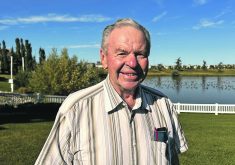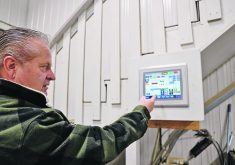Exercise releases hormones that allow muscles to absorb amino acids, which helps them grow and reduces their breakdown
Last July, Ruth Chorney underwent surgery to have her left hip replaced. About a month before, the retired educator and farmer began doing specific exercises recommended to her by her physiotherapist; exercises designed for the needs of a hip replacement candidate.
A life-long active woman, she welcomed the opportunity to participate in her health outcome. “The idea was to start training my muscles and training myself for after surgery,” she said in a phone interview.
She is convinced that the exercises recommended by her physiotherapist helped ready her body for surgery, and helped and continue to help in her recovery. And the results speak for themselves.
Read Also

Farming Smarter receives financial boost from Alberta government for potato research
Farming Smarter near Lethbridge got a boost to its research equipment, thanks to the Alberta government’s increase in funding for research associations.
Six months post-op, Chorney said she feels great. She’s hiking 45 minutes to an hour most days. She can lift up to 40 pounds and contrary to pre-op predictions, she can still touch her toes.
In the months before surgery, the calf of her left leg had shrunk, through reduced use, to one inch smaller than her right. Just six months post-op, there is only a difference of one-eighth inch.
Even for those fortunate enough not to require hip replacement surgery, regular exercise can bestow benefits and Chorney feels she is an example that others could follow.
Weight-bearing and resistance training exercises can protect bone health in older adults, including those with low bone density.
As early as our 30s we begin to lose muscle mass and function. Regular physical activity can reduce muscle loss and allow people to maintain strength as they age. Exercise helps release hormones that promote the ability of muscles to absorb amino acids. This helps them grow and reduces their breakdown.
Regular exercise can reduce risk of disease.
According to World Health Organization’s global strategy on diet, physical activity and health:
“Physical inactivity has been identified as the fourth leading risk factor for global mortality (six percent of deaths globally). Moreover, physical inactivity is estimated to be the main cause for approximately 21 to 25 percent of breast and colon cancers, 27 percent of diabetes and approximately 30 percent of ischaemic heart disease burden.”
Exercise can mitigate the effects of chronic inflammation.
Not to be confused with acute inflammation, the redness and warmth around a cut or scrape, chronic inflammation is triggered by compounds from abdominal fat, gum disease and other factors. Chronic inflammation may increase the risk for heart disease, diabetes, dementia and some cancers.
A study at the University of California’s San Diego School of Medicine, led by Suzi Hong from the Department of Psychiatry and the Department of Family Medicine and Public Health Researchers, suggested that 20 minutes of exercise per day may help fight inflammation in the body.
Exercise increases the production of endorphins, hormone-like substances produced in the brain, which have been shown to reduce our perception of pain. Secretion of endorphins also leads to feelings of euphoria, and high endorphin levels cause us to feel fewer negative effects of stress.
Aerobic exercise can help maintain the size and functioning of the brain as we age.
A collaborative study by Australian and English researchers found that aerobic exercise can help to maintain the size of the brain as we age, aiding in maintenance of brain health and memory function. The study was led by researchers from Australia’s National Institute of Complementary Medicine at Western Sydney University, along with the Division of Psychology and Mental Health at the University of Manchester in the United Kingdom.
Brain scans of participants (average age 66) were examined before and after aerobic exercise programs or in control conditions. The study specifically was looking at the effects of exercise on the hippocampus, a region of the brain critical for memory and other brain functions.
The aerobic exercise included stationary cycling, walking and treadmill running, with the length of the interventions ranging from three to 24 months with a range of two to five sessions per week.
The results showed no effect on total hippocampal volume, but exercise did significantly increase the size of the left region of the hippocampus. (Our brains shrink over time, about five percent per decade after age 40.)
Exercise can help us live longer, say researchers. A study of 5,700 men aged 68 to 77 in Norway showed that those doing three hours of exercise a week lived about five years more than those who were sedentary.
Those logging the equivalent of six, 30-minute sessions of any intensity were 40 percent less likely to have died during the 11-year study. On the other hand, the study found that doing less than an hour a week of light exercise showed no effect.

















